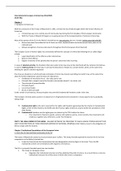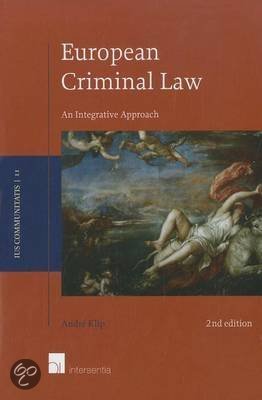International & European Criminal law 2014/2015
André Klip
Chapter 1
1. European Criminal Law
With the conclusion of the Treaty of Maastricht in 1992, criminal law was finally brought within the formal influence of
Union law.
Criminal law was not a central area of Community law during the first decades of the European Community
With the Treaty of Maastricht began an on-going process of the Europeanisation of national criminal law.
Most of the powers of the EU in the field of criminal law are not exclusive, but are, instead, jointly excersied with MS.
Norms have been formulated at the EU level, but their implementation and enforcement takes place at the
national level.
Mutual recognition of various documents throughout the EU (European Arrest Warrant)
The European Court of Human rights has consistently defined the concept of criminal by following the so-called Engel
criteria:
1. Legal classification of the offence under national law
2. Nature of the offence
3. Degree of severity of the penalty that the person concerned risks incurring
In cases of absolute priority, the freedoms that exist under Union law may not be interfered with by national criminal law.
In case of relative priority of Union law, it narrows the discretion of States to a certain extent, while, at the same time,
allowing for specific national regulation
One may see situations in which particular priniciples of Union law may be overriding, but which may, at the same time,
allow for further elaboration upon the basis of national law:
Prohibition of retroactive force – the nulla poene rule
Principle that a suspect cannot be forced to incriminate himself – lex mitior rule
The principle of proportionality
Principle of guilt
Lex certa principle
Ne bis in idem principle
Under certain circumstances, these principles may override fundamental freedoms under Union law.
The European criminal justice system is in place but it is fragmented and inconsistent in many aspects, but is, gradually,
taking shape
❖ Fundamental rights is the term reserved for the rights and freedoms guaranteed by the charter of Fundamental
Rights of the EU (the Charter), the ECHR and other human rights treaties to anyone within the jurisdiction of the
State Parties.
❖ Fundamental freedoms are the rights given to citizens by the TFEU within the Union.
o Free movement of persons, goods, services and capital as well as, more recently, free movement and
residence, together also referred to as the ‘five freedoms’
PART 1 THE LEGAL ORDER OF THE UNION – BALANCE BETWEEN THE FREEDOMS TO WHICH UNION CITIZENS ARE ENTITLED
AND THE RESTRICTIONS OF THESE FREEDOMS IMPOSED BY NATIONAL (CRIMINAL) LAW. Mainly concerns the obligations of
MS to comply with the treaties.
Chapter 2 Institutional foundations of the European Union
2. From the EU Coal and Steel community to the EU
The treaty of Maastricht created a structure based upon 3 pillars. This treaty formally opened the way for the EU to have
competence in the field of criminal law.
It was the Council (not the Commission) that was designated as the key figure in this area. Thus, the MS
maintained control over all initiatives with regard to criminal law.
The EU is is primarily founded upon two new treaties:
1. The Treaty on European Union
a. Regulates the institutional structure and has abolished the pillar structure. As a result there is only one
institutional structure for all the areas in which the Union is competent.
, 2. The Treaty on the Functioning of the European Union
Some MS took initiatives in the form of further conventions, mainly in the field of co-operation in criminal matters:
1985 Schengen Agreement
1990 Convention Implementing the Schengen Agreement (CISA)
2005 Treaty of Prum on cross-border co-operation in criminal matters was concluded between a limited number
of MS
3. Two converging areas: The Internal market and the area of Freedom, Security and Justice
3.1 A New Legal Order
Union law creates a new legal order, which has become an integral part of the legal systems of the MS, and which their
national courts are bound to apply, independently of the various sub-areas of law.
Union law is directly applicable;
In Costa v. ENEL and in Internationale Handelsgesellschaft, the Court held that the application of rules of national
law would deprive the law set out in the Treaties of its independent nature.
3.2 Sincere co-operation
MS have a general obligation to enforce the law of the Union
Article 4 paragraph 3 TEU
It creates a positive duty to carry out all obligations, as well as an obligation to refrain from doing anything that
might be contrary to the objectives of the Union.
3.3 The three pillars of Maastricht
1. In the first pillar, community law found a place
2. The second pillar was where a common defence and foreign policy took shape and was relevant for sanctions and
boycotts
3. In 1992 the third pillar related to co-operation in the area of justice and home affairs. Five years later the title was
the area of freedom, security and justice.
a. Under this pillar criminal law is the main enforcement instrument.
In that time the internal market prevailed over the third pillar, which was very vague and far less concrete than those of the
internal market without borders.
Third pillar law preserved its purely international law character. It had no direct effect, so that implementation
into national law was always necessary.
Court extended the enforcement obligation also to the Third pillar. In Pupino the court rejected the argument that
the treaty of the EU did not contain an obligation similar to that laid down in Article 10 TEC.
3.4 One legal order for the Union
Differences are disappearing as a result of the Court’s case law and the Treaty of Lisbon;
Which creates one institutional framework that goes hand in hand with the complete merger of the internal
market and the area of freedom, security and justice.
As a result the principle of sincere co-operation now governs all areas, including that of criminal law.
3.5 Application of internal market principles on the area of Freedom, Security and Justice
One consequence of the complete merger of the internal market and the area of freedom, security and justice is that all the
principles that have been developed under Community law for the realisation of the internal market are now fully
applicable to all fields of Union law, including former Third Pillar law.
This is subsequently codified in the Treaty of Lisbon.
In criminal law the concept of external borders does not play a role.
Criminal law is not oriented towards a specific area that must be defended against and by others, but on
controlling the undesirable behaviour of persons residing within and outside the area, regardless of whether they
are allowed to reside there or not.
The most obvious way of using internal market principles in the criminal justice area is the development of the
principles of mutual recognition and availability.
o This leads to a concept of free movement for decisions, information and evidence
o It does not directly help the citizen, but does aid the (authorities of the) MS.
▪ This change of beneficiaries of mutual recognition is one of the most important and
challenging aspects of the merger of the internal market and the area of freedom, security
and justice.
, 4. European Integration
4.1 European integration
This can be defined as the progressive process of bringing European State, European peoples and their societies closer
together.
Integration need not necessarily take place in a legal form; this is where the distinction with harmonisation lies.
Harmonisation has a legal connotation. Harmonisation is the convergence of the legal practice of various legal
systems based upon a common standard. It can be considered a legal means for achieving the political objective
of integration.
o It constitutes an attempt to reduce these differences, but its ultimate goal is not to eliminate them
Harmonisation distinguishes itself from mutual recognition. The mutual recognition of legal differences is an
acknowledgement of the MS right to be different and their desire not to change. It aims to make the differences
irrelevant.
Need for integration and harmonisation
Criminal law was the exclusive domain of the MS. The integration offered is that the Union provides its citizens an area of
freedom, security and justice.
Three levels of rationalisation of the need for integration and harmonisation
1. Macro-level: ONE Europe!
2. Meso-level: general purpose of fighting crime or improved co-operation
3. Micro-level: solutions for all manner of practical problems
a. Examples: setting up of joint investigation teams, Eurojust, the European Judicial Network and the
description of ‘good practices’ in mutual legal assistance.
Factors that obscure the need
1. A difference of opinion on the role that criminal law should play in European society.
2. The struggle for power within the European Union
a. Runs parallel with the question whether or not the EU should be in charge of a certain area, or whether
it should be left to the MS.
4.2 Common policies and co-ordination
Art. 3 TFEU stipulates the areas in which the Union is to have exclusive competence.
Art. 4 TFEU deals with the areas in which the Union shares its competences with the MS.
Gradually, a common approach to certain problems in the area of freedom, security and justice has been developed
4.3 Tools
In essence, the EU uses two legal tools to pursue its objectives:
1. Hard law
a. Is legislation, and the backbone of integration and harmonisation
Form and means:
European legislation in the area of criminal law must be put into effect by means of implementation into the national legal
system – it creates layers of legislation
2. Soft law
a. Refers to those control instruments that are not legislation, but which may, however, be based upon
legislation
Form and means:
More policy oriented areas (“soft law”)
The EU does not determine precisely what the rules that must be formulated are, but it does determine that action must be
taken on a particular theme. (Art. 67 TFEU gives legal standards).
The higher the political priority, the more difficult it is for a MS to avoid a common policy and follow its own course,
because the legal instruments are drafted more forcefully and there is more political pressure.
Thus, at a certain point in time, it seems politically inevitable to group the obligations in the various soft law
instruments and translate them into hard law
4.4 Harmonisation and approximation
Positive and negative integration:
Positive:
Refers to areas in which the Union harmonises the substantive law in a certain field and, as a consequence of this,
the discretion of the MS for other measures becomes increasingly limited.
o Framework Decisions and criminal law Directives also have the effect of positive integration.
Negative:







